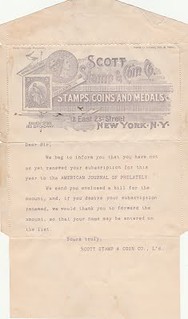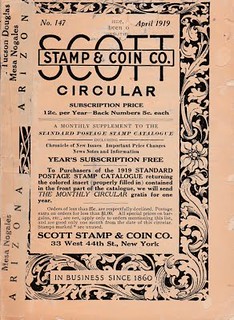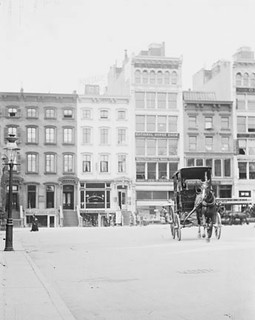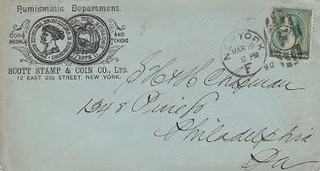
PREV ARTICLE
NEXT ARTICLE
FULL ISSUE
PREV FULL ISSUE
SCOTT STAMP & COIN COMPANY, LTD.John Lupia submitted the following information from his Encyclopedic Dictionary of Numismatic Biographies for this week's installment of his series. Thanks. This
week's subject is the Scott Stamp & Coins Company, Ltd. It's a lengthy article for a long-lived organization. The story has many twists and turns over the years. As always, this is just an
excerpt with the full article and bibliography available online. -Editor
PRELIMINARY REMARKS
In 2004, the global number of philatelic collectors was estimated at 30 million. In 2007, Linn’s Stamp News, conducted a philatelic market survey measuring the size of the American collectible stamp industry finding it at $1.18 billion. Also, in a 2007, Mike Hall of Stanley Gibbons estimated that "About $1 billion of rare stamps trade annually in the $10 billion-a-year stamp market." In 2009, Adrian Roose of Stanley Gibbons estimated the philatelic collectors population at 48 million. In 2014, the U. S. numismatic market was estimated at $5 billion per year, half the philatelic global market estimated ten years previous in 2007. Yet, Coin World reported in 2016 the U. S. numismatic market just topped $4 billion, over $900 million less. The root of this myopia between both fields of coins and stamps harks back to that period when Lyman Haynes Low resigned as manager of the coin and medal department of Scott Stamp & Coin Co., Ltd in mid to late May 1896, when he completed the sales of the last coin auction for that corporation. In the ensuing fifty years or so the two fields slowly grew apart and remote to the alienation and estrangement of one from the other. A record of this evolving myopia was published in both Scott's Monthly Journal and The Numismatist in the first quarter of 1930. Below is a quote from the April 1930 issue of The Numismatist page 224. It seems that the philatelists were the first to think and say, "I thought coins died and went out years ago," which I heard echoed by numismatists in January 2017 regarding stamps. However, the coin industry back in 1930 acknowledged that the market wained at one point in the past but recovered and continued to grow steadily strong, healthy and robust. Both stamp and coin markets have experienced continued steady growth since Black Tuesday, October 29, 1929. One of the goals of NumismaticMall.com is to reintroduce the two mighty arms of the numismatic market to one another, namely stamps and coins. They really are not two unrelated fields at all, but two sectors of one very large market of numismatic collectibles. In order to properly appreciate and comprehend numismatic history it is essential to integrate both in our historical and biographical studies. Many of the great collectors and dealers of the past were deeply involved in both stamps and coins. One of the first popular numismatic magazines of the past makes this crystal clear even in its title : Mason's Coin and Stamp Collectors Magazine. It is an anachronistic perspective that expresses the notion that preeminent dealers like S. H. & H. Chapman only sold stamps when the coin industry was slow. The Chapman Brothers were both stamp and coin dealers who enjoyed both fields as did others besides W. E. Woodward, Ebenezer Locke Mason, Jr., John Walter Scott, John W. Haseltine, David Proskey, Ed Frossard, William P. Brown, Harlan Page Smith, Robert W. Mercer, Henry Ahlborn, John Hubbard, W. E. Skinner, J. G. Bingham, Lewis T. Brodstone, Hiram E. Deats, D. T. Eaton, Frank E. Ellis, Burdette G. Johnson, John W. Kline, A. C. Roessler, to mention only just a few of the better known dealers, not including dozens of those lesser known. Many of the great collectors of the past also amassed famous collections of both stamps and coins. The biographical sketch below is of a corporate entity known to both fields of stamps and coins, i.e., Scott Stamp & Coins Company, Ltd. which in the heyday of numismatic growth and development was the hub of unity among collectors and dealers in both sectors of the numismatic market. These two fields have become estranged since the late 1940's and leading exponents today have a muddled vision of this now defunct corporation. Surprisingly, most people, including well informed numismatists, excepting Lorraine S. Durst, have a blurred vision of just what exactly Scott Stamp & Coin Company, Ltd. was. Typically most numismatic and philatelic researchers conflate the Scott companies by mixing them up and lumping them all together as one continuous blob of corporate catalogues and auctions. In numismatic literature Lorraine S. Durst got it right keeping them separate. In philatelic literature the editors of the Crawford Catalogue, Edward D. Bacon and D. R. Beech, got it right also by keeping them separate. It is understandable how even the best researcher can get mixed up and confused. Scott Stamp & Coin Company, Ltd.
Below is the story of Scott Stamp & Coin Co., Ltd. which resulted from John W. Scott selling all of his company stock and the syndicate that bought it wasted no time renaming it Scott Stamp & Coin Company, Ltd. The first auction catalogue bearing the new name was sale No. 70 issued February 15, 1886. The third Scott company was formed after John W. Scott left his company (now renamed Scott Stamp & Coin Company, Ltd.), in which he returned to his original name John W. Scott & Co., Ltd., and for which he was sued by Scott Stamp & Coin Company, Ltd., claiming it to be an infringement. John W. Scott won the lawsuit and was allowed to continue in business using his own personal name.
See John's web site for more; it's a long and complicated story. The early history of coin and stamp collecting in the U.S. is quite intertwined and the early literature is difficult to sort into today's seperate categories - most dealers and publishers of the day handled both coins and stamps. Are the two hobbies lost lost brothers? -Editor   To read the complete article, see:
Wayne Homren, Editor The Numismatic Bibliomania Society is a non-profit organization promoting numismatic literature. See our web site at coinbooks.org. To submit items for publication in The E-Sylum, write to the Editor at this address: whomren@gmail.com To subscribe go to: https://my.binhost.com/lists/listinfo/esylum All Rights Reserved. NBS Home Page Contact the NBS webmaster 
|

